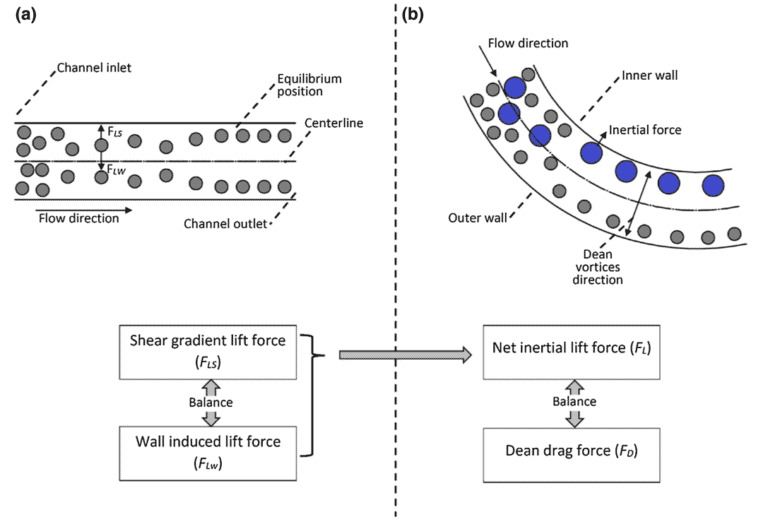Microfluidic Cell Size Sorting Instrument Pack
Spiral channel for microfluidic inertial cell sorting by size
Easy cell sorting experiment
Unbox, set up and start your experiments right away
Spiral cell sorting chip
Passive, inertia-based sorting of the cells by size
The advantages of microfluidics
Low reagent consumption, improved safety, easier to use
Principle figure by Ramachandraiah et al. (2014).
Microfluidic cell sorting
Cells can be sorted according to size using the microfluidic cell size sorting pack. This pack is based on a highly accurate flow controller and a spiral sorter chip. This all-in-one solution contains all the required microfluidic instruments to set up a cell sorting system with a high flow rate and good sorting performance.
Our microfluidic experts will help you throughout the whole setup process of your experiment making this pack usable by microfluidic technology beginner users.
The cell separation technique is label-free, membrane-free, and based on well-understood Dean forces. This pack can also be used to separate sperm cells from red blood cells.
A microfluidic cell sorting pack contains a flow controller to push the sample containing the cells inside the microfluidic chip, which uses Dean’s force to separate them by size. The efficiency of the sorting will be directly linked to the fluid’s properties and also to the flow rate inside the channel. Our new flow sensor, Galileo, is especially suited for this application. If you want to know more about the Galileo project, follow this link.
Thanks to a manifold that separates the flow before the microfluidic chip, the process’s throughput can be easily increased by parallelizing it with the use of several microfluidic channels at the same time.
This pack can also be used for passive sperm sorting.
Microfluidic cell sorting pack setup
This pack brings together compatible instruments and allows you to easily start the experiment. A single software pilots everything, and it can be adapted and applied to other ends. The following figure summarizes the montage that can be set up with the pack.

The cell sorting pack contains:
Flow sensor (Galileo, MIC)
Software (Galileo user interface)
Flow controller
15 mL Falcons
A commercial spiral microfluidic chip with several outlets
All necessary accessories: connectors, filters, tubing, etc…
Microfluidic cell size sorting principle
Cell sorting is a critical step in many biological, biotechnological and medicine experiments [1]. It is especially useful to enrich cell samples by increasing their concentration for diagnostic or treatments [2]. It can also be used to remove cells from plasma which is necessary for some early cancer detection techniques that use serum biomarkers [3-4].
Several methods exist to sort cells in a microfluidic chip, including acoustic, magnetic, and optical mechanisms [5]. The microfluidic cell size sorting Pack uses a label-free inertial separation and sorting technique using Dean forces that create vortices inside the microchannel [6]. Theses vortices appear in the spiral shape channel because of the velocity difference between the fluid near the inner wall and the velocity of the fluid near the outer wall of the microfluidic channel [7].
Therefore, the balance between the Dean force and the inertial force creates a separation between the smaller cells that are dragged toward the outlet of the spiral because the Dean force is predominant and the larger cells are dragged toward the inner wall of the microchannel [8].
The effectiveness of the sorting depends on the Dean Number. This number increases when the Reynolds number increases, and the radius of curvature decreases [9].
References
C. Wyatt Shields IV, Catherine D. Reyes and Gabriel P. López, Microfluidic cell sorting: a review of the advances in the separation of cells from debulking to rare cell isolation. Lab Chip, 2015, 15, 1230-1249
Gossett, D.R., Weaver, W.M., Mach, A.J. et al. Label-free cell separation and sorting in microfluidic systems. Anal Bioanal Chem 397, 3249–3267 (2010)
Villanueva J., Shaffer D., Philip J., Chaparro C., Erdjument-Bromage H., Olshen A., Fleisher M., Lilja H., Brogi E., Boyd J., Sanchez-Carbayo M., Holland E., Cordon-Cardo C., Scher H., Tempst P., Differential exoprotease activities confer tumor-specific serum peptidome patterns, J. Clin. Invest., 116, 271–284 (2006)
Jinong Li, Zhen Zhang, Jason Rosenzweig, Young Y Wang, Daniel W Chan, Proteomics and Bioinformatics Approaches for Identification of Serum Biomarkers to Detect Breast Cancer, Clinical Chemistry, 48, 8, 1 August 2002, 1296–1304
Pu Chen, Xiaojun Feng, Wei Du, Bi-Feng Liu, Microfluidic chips for cell sorting, Frontiers in Bioscience 13, 2464-2483, January 1, 2008
Nivedita, N., Ligrani, P. & Papautsky, I. Dean Flow Dynamics in Low-Aspect Ratio Spiral Microchannels. Sci Rep 7, 44072 (2017).
Zhang J., Yan S., Yuan D., Alici G., Nguyen N-T., Warkiani M.E., Li W., Fundamentals and applications of inertial microfluidics: a review, Lab Chip, 2016, 16, 10-34
Al-Faqheri, W., Thio, T.H.G., Qasaimeh, M.A. et al. Particle/cell separation on microfluidic platforms based on centrifugation effect: a review. Microfluid Nanofluid 21, 102 (2017).
Yoon DH, Ha JB, Bahk YK, et al. Size-selective separation of micro beads by utilizing secondary flow in a curved rectangular microchannel. Lab on a Chip. 2009 Jan;9(1):87-90.
Why use microfluidics for cell size sorting?
The basic principle of microfluidics is to use tiny volumes of sample which can be a critical improvement for valuable cell solutions.
Moreover, cell sorting on microchips are simpler than more conventional methods as it is label-free and relies only on mechanical forces and, moreover, eliminates potential biohazardous aerosols.
Cell sorting using a spiral microchannel relies on the Dean forces, which are stronger when the Reynolds number is low. The Reynolds number in a microfluidic channel is usually very low, so this cell sorting technique is almost only usable in microfluidic experiment conditions.
Tuning the fluid velocity can optimize cell sorting. Different outlets on one microfluidic chip can also be used to separate different entities. Microfluidic spiral chips allow more flexible, precise, and efficient cell sorting.
Cell sorting can be integrated into bigger microfluidic platforms for more complex processes.

References
1. Al-Faqheri, W., Thio, T.H.G., Qasaimeh, M.A. et al. Particle/cell separation on microfluidic platforms based on centrifugation effect: a review. Microfluid Nanofluid 21, 102 (2017).
Customize your pack
It is possible to find commercially available spiral chips for cell sorting with different materials, spiral, and channel sizes. You can also fabricate your own design using various fabrication techniques.
The efficiency of the sorting depends on the Reynolds and Dean numbers. If you have any doubts about the settings best suited for a specific application, get in touch with one of our experts!
Supplementary Flow controller channels and flow rate sensors can be added to the Pack to fit a specific application.
Bubbles can be a problem when mixing. If this issue is critical to the experiment, a bubble remover can be provided.
Contact our experts to answer any questions about this cell sorting Pack and how it can match your specifications by sending a message via the button below.
Frequently asked questions
How can we help your experiment?
This pack is in beta testing phase. So, although the instruments are not fully industrialized, we can provide extensive support as part of our beta testing program. Get in touch to see if you are eligible.
Can a pack be customized based on my specific application?
Yes! Our experts will establish which instruments are best suited for your application, such as the type of flow sensor or the number of flow controller channels you need to perform your experiment. Contact us using the “talk to our experts” green button above.
Can I buy individual instruments?
Our instruments are in beta testing phase and can be tested as a pack or individually, so get in contact with our team to know how our beta testing program works.

